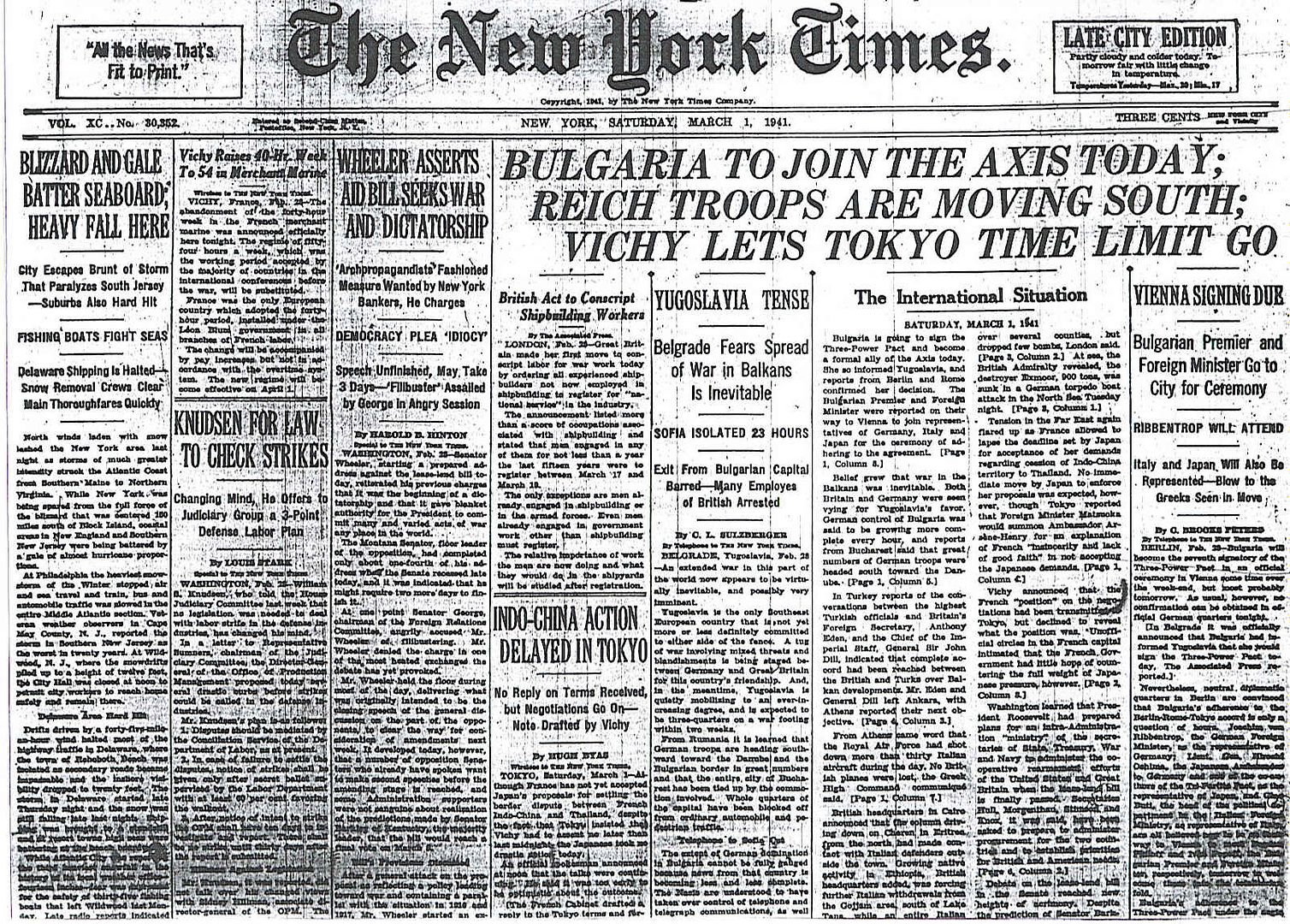
Posted on 03/01/2011 4:29:49 AM PST by Homer_J_Simpson

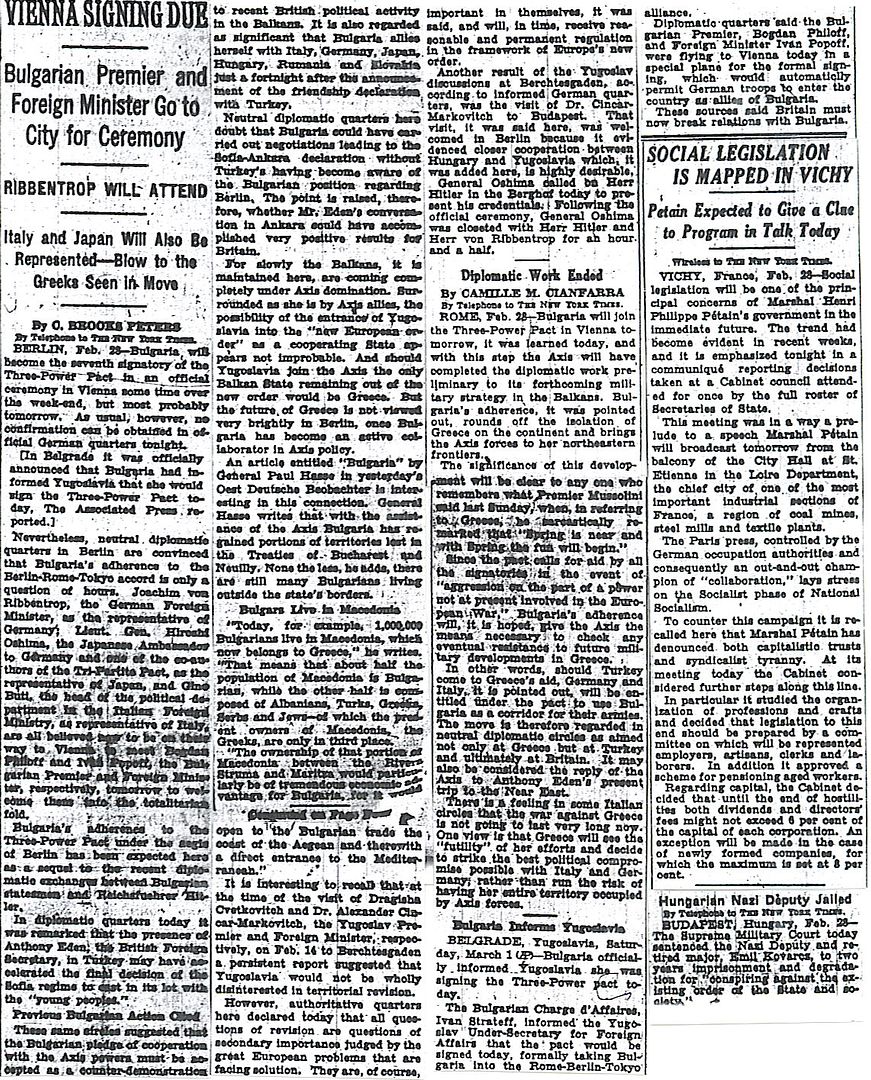
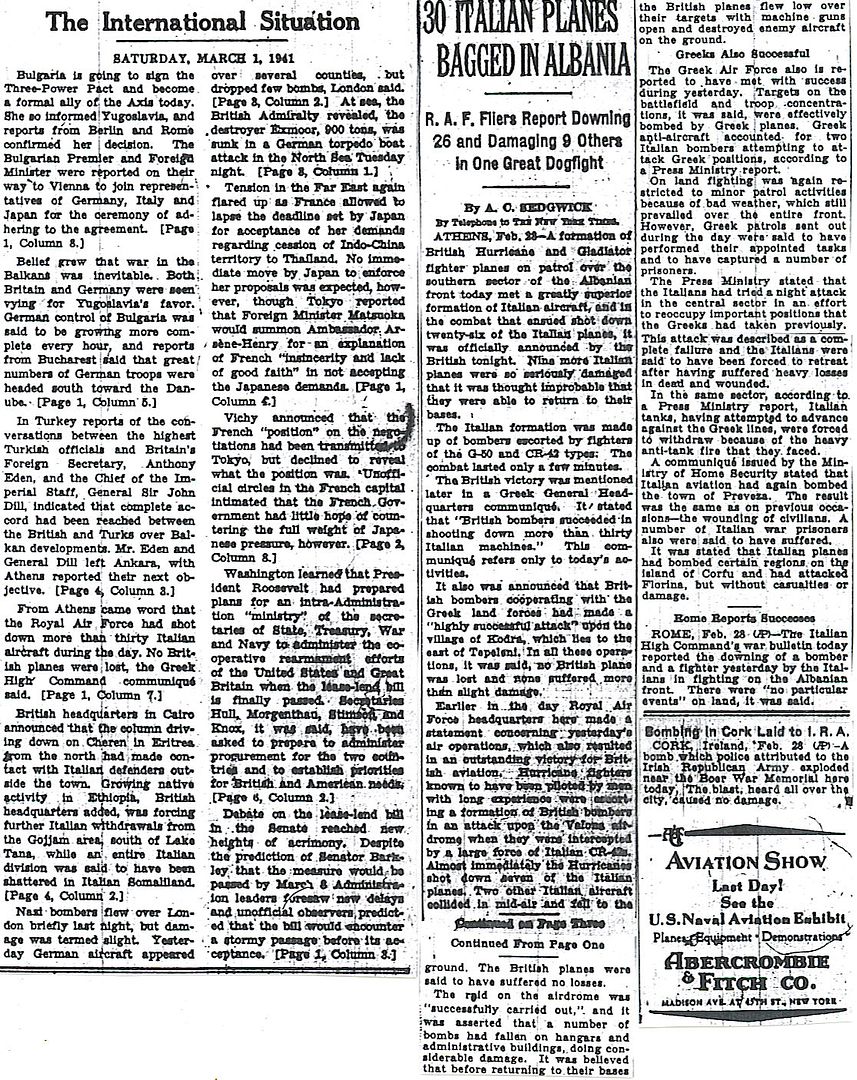
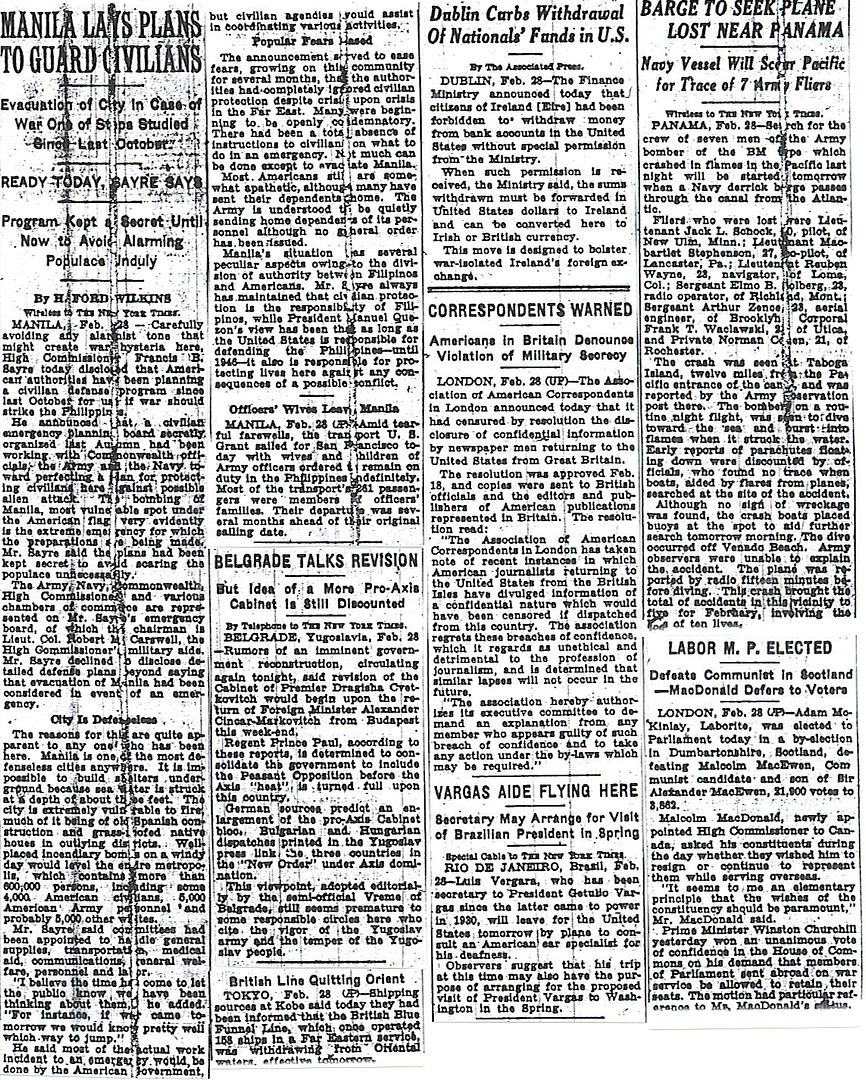
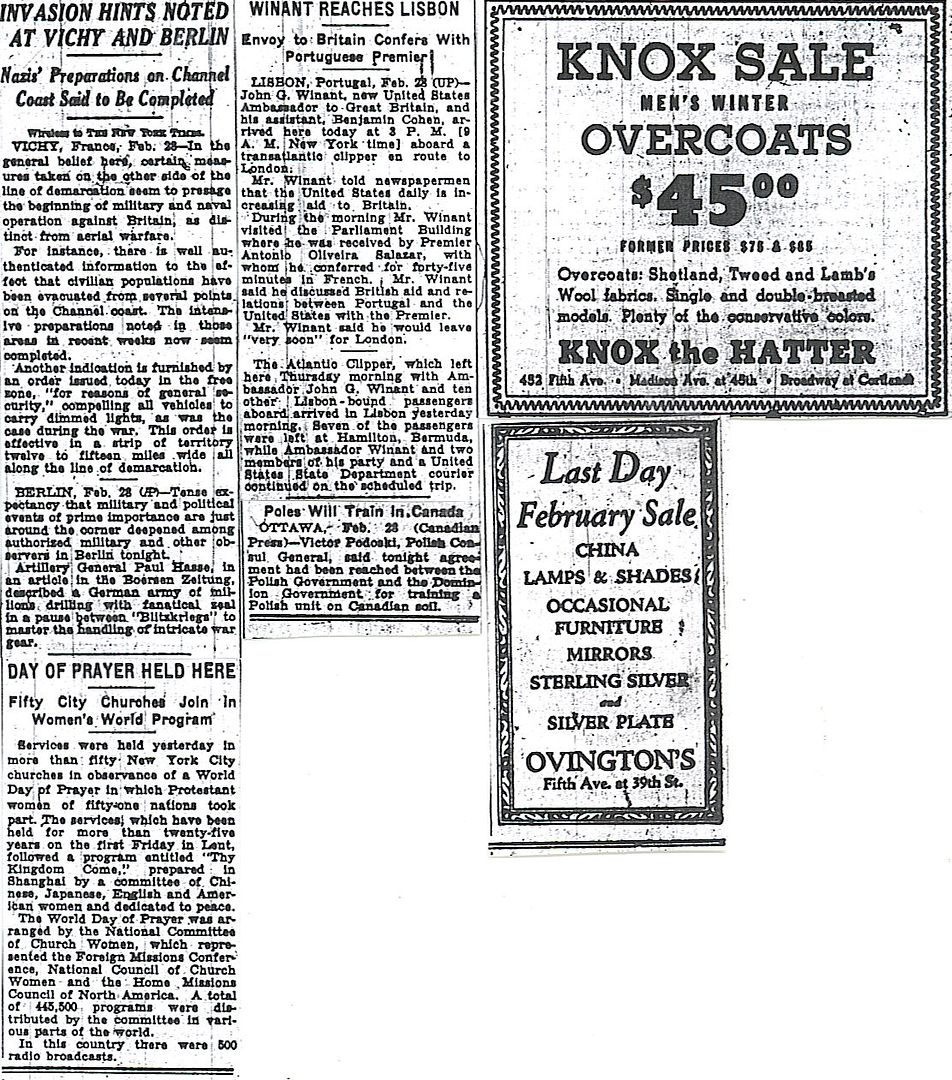
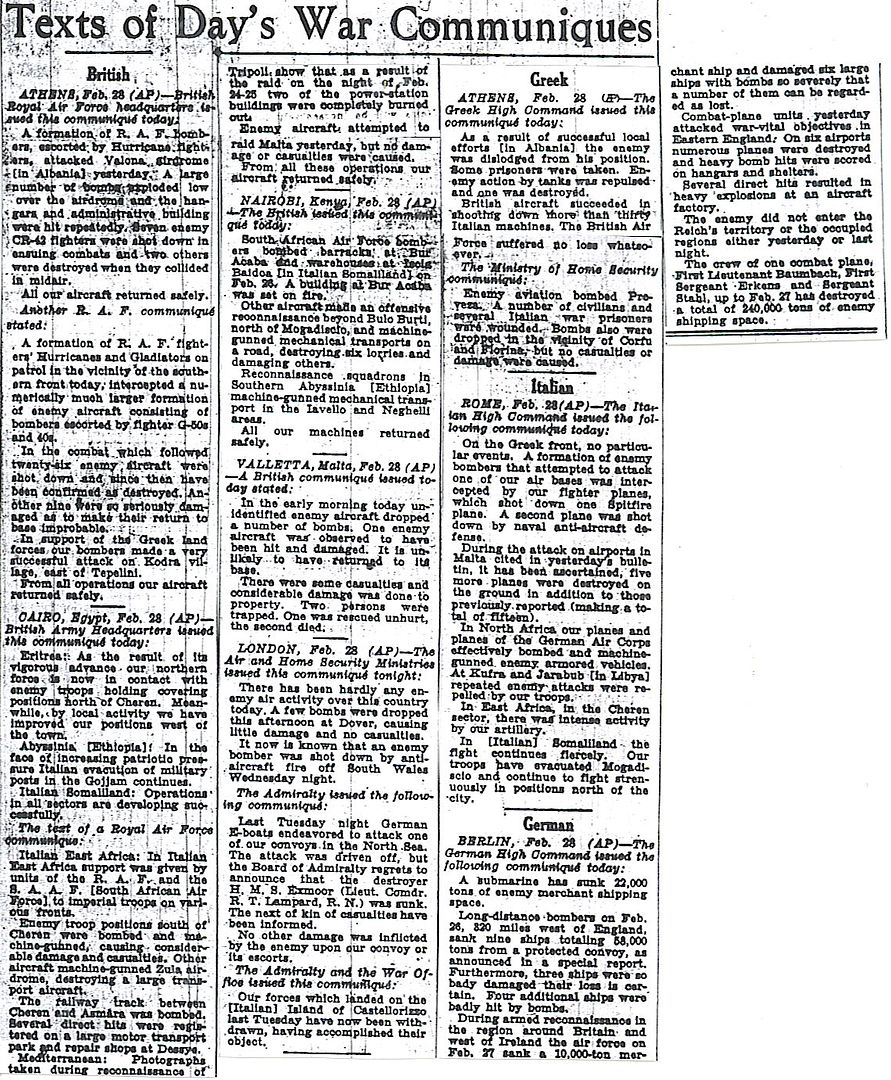
#1 - “Frenesi”-Artie Shaw
#2 - “I Hear a Rhapsody” - Charlie Barnet, with Bob Carroll
#3 – “High on a Windy Hill” – Gene Krupa, with Howard Dulaney
#4 - “Perfidia” - Xavier Cugat
#5 - “It All Comes Back to Me Now” - Hal Kemp, with Bob Allen
#6 – “You Walk By” – Eddy Duchin, with Johnny Drake
#7 – “I Hear a Rhapsody” – Jimmy Dorsey , with Bob Eberly
#8 - “Song of the Volga Boatmen” - Glenn Miller
#9 - “Anvil Chorus” – Glenn Miller
#10 - “Oh Look at Me Now” - Tommy Dorsey, with Frank Sinatra and the Pied Pipers
Vienna Signing Due – 2
Social Legislation is Mapped in Vichy – 2
The International Situation – 3
30 Italian Planes Bagged in Albania – 3
Manila Lays Plans to Guard Civilians – 4
Dublin Curbs Withdrawal of Nationals’ Funds in U.S. – 4
Barge to Seek Plane Lost Near Panama – 4
Invasion Hints Noted at Vichy and Berlin – 5
Texts of Day’s War Communiques – 6
http://www.onwar.com/chrono/1941/mar41/f01mar41.htm
Mines keep carrier from Mediterranean
Saturday, March 1, 1941 www.onwar.com
In East Africa... The carrier Formidable attacks Massawa again. German mines blocking the carrier’s entry into the Mediterranean are being cleared.
From Washington... The US Navy forms a Support Force for the Atlantic Fleet. The main part of this unit is made up from three destroyer squadrons of 27 ships.
In Sofia... Prime Minister Filov brings Bulgaria into the Tripartite Pact.
In North Africa... Kuffra in southeast Libya is taken by a Free French force from Chad. Colonel Leclerc is in command. The French force has received some help from units of the British Long Rage Desert Group.
http://worldwar2daybyday.blogspot.com/
Day 548 March 1, 1941
Reichsfuehrer-SS Heinrich Himmler inspects the concentration camp at Auschwitz, Poland (population 10,900). He orders it expanded to hold 30,000 prisoners and a new camp built 4 km away, at the village of Birkenau, for an expected 100,000 Soviet prisoners of war.
Bulgarian Prime Minister Bogdan Filov signs the Tripartite Pact allowing Germany to attack Greece through Bulgaria. In return, Hitler offers Bulgarian Tsar Boris III all the territory lost in WWI to Serbia and Greece.
US Navy forms Support Force, Atlantic Fleet, comprising destroyers and patrol plane squadrons to protect convoys on the American side of the Atlantic Ocean.
Italian garrison (29 Italian officers & NCOs, 273 Libyan soldiers) surrenders El Tag fort and Kufra oasis in Southeastern Libya to Free French troops. Italian casualties are 3 Libyan soldiers killed & 4 wounded, while French have 4 dead & 21 wounded.
Eritrea, East Africa. 2 battalions from 4th Indian Division and 2 Free French battalions (under British Brigadier Rawdon Briggs) reach Mescelit Pass 15 miles Northeast of Keren. “Briggs Force” lacks artillery for a major offensive but will distract the garrison at Keren and cause Italian reserves to remain at port of Massawa instead of reinforcing Keren. As German mining of the Suez Canal keeps British aircraft carrier HMS Formidable at anchor in Port Sudan, she launches 5 Fairey Albacore biplanes to bomb Massawa harbour, but they do little damage. Italian submarines Gauleo Ferraras, Perla and Archimede begin escaping from Massawa. They will go around the Cape of Good Hope, refuel from German vessels and arrive at Bordeaux, France, between May 7-20.
British minesweeping trawler HMT St. Donats sinks in a collision with escort destroyer HMS Cotswold 45 miles East of Grimsby, England.
Every day - I wonder where I would be in politics if I we alive 70 years ago. Just wonder.....
I've been thinking about that for a while and I decided it is impossible to arrive at a meaningful answer. You have to make so many assumptions about your hypothetical background that you can make yourself anything from an America-First isolationist to a fervent New Dealer. Or we could have been radicalized by circumstances and turned into a Communist or Nazi sympathizer.
http://homepage.ntlworld.com/andrew.etherington/month/thismonth/01.htm
March 1st, 1941
UNITED KINGDOM: Churchill tells Eden that in the light of the Turkish reluctance to join in the war, he should concentrate his efforts on Yugoslavia and encourage her to attack south to produce an Italian disaster in Albania.
John. G. Winant the new US ambassador is welcomed by the King.
Convoy EN79 departs Methil, Fife, at 0630.
TEWKESBURY as Commodore-ship led the port column, (ATHELTEMPLAR as Vice Commodore-ship led the starboard column). Escorts were HMS FOWEY, and HM Trawlers HUGH WALPOLE, and INDIAN STAR. Convoy WN91 (opposing route to EN79) was still en route on the evening of 1st March. Reconnaissance flights by the Luftwaffe during the day would have charted the speed of both convoys and forecast their arrival together off the Aberdeenshire coast. Three aircraft were commonly employed in such attacks and would have split-up off-shore, approaching the shore in line-abreast, about 15kms apart, to search for shipping. If an aircraft missed the convoy, it usually attacked coastal targets. The convoy progressed through a stiff north-easterly wind and sea, without incident until dusk that day. Sunset in the area would have been at 1738 GMT (1838 local time), and it was three days after a new moon, with the moon in the western hemisphere, setting at 2225. Thus the moon, if it was visible, was showing less than a quarter, and was close to its zenith. The weather over most of the UK was cloudy with poor to moderate visibility. Air cover of three hurricanes was provided throughout the daylight hours, and was withdrawn, as was normally the case 30 minutes after sunset. Then 45 minutes after sunset, with Girdle Ness bearing 276°, distance 7½ miles [TEWKESBURY position 57º 09’ N, 1º 46’ W], the convoy was attacked by enemy aircraft. Initially an aeroplane was sighted by HUGH WALPOLE [Range 2 miles, bearing NNW] approaching from the North, and challenged by her. The aircraft altered course and headed for HUGH WALPOLE who opened fire with Lewis guns when the aircraft was in range. A small object dropped from the aircraft, fell into sea and did not explode. The aircraft opened fire with machine guns, and after passing over HUGH WALPOLE headed for the convoy.
Two minutes later a Norwegian ship was spotted by FOWEY showing her fore steaming light, so FOWEY began turning to order her to desist. During this turn ATHELTEMPLAR was hit on the navigation bridge and bridge deckhouse by three bombs. The enemy aircraft, a Heinkel 111 heavy bomber, was heard in the vicinity about two minutes before the attack, and then observed rapidly bearing down from right ahead at a height of approximately 250 feet, towards ATHELTEMPLAR at the head of the starboard column. The bombs that struck her exploded instantly and caused an immediate devastating fire. The Master, Capt A. Waterson, and all executive officers except Chief Officer J.M. Scott were killed, and the Chief Officer was severely injured as he was blown from the bridge to the forecastle by the blast. FOWEY opened fire four times
with barrage fire, but hit nothing. At the same time the ss TEWKESBURY
gave the enemy a burst from her starboard Hotchkiss to which he replied with his rear machine gun, causing minor damage to deck fittings, but no casualties were inflicted. The bomber flew down the length of the convoy, using his machine gun or guns and increased his altitude rapidly at the same time, before disappearing to the rear of the convoy but could be heard faintly at frequent intervals lurking in the vicinity. Simultaneously in
WN91 an enemy aircraft was sighted flying 320° distance about 2 miles on port beam, and engaged from time to time by FORTHBANK, CURAÇOA, and other escorts and vessels in the convoy. Shortly after, it reappeared flying up the two columns being engaged continuously, and then flew out of sight. The fire aboard ATHELTEMPLAR was reported as being “a ship on fire” off Whinnyfold, Cruden Bay by coastguards (Register of Air Raids 1941). The ATHELTEMPLAR was much further away (three to four times the distance reported), amply illustrating the intensity and magnitude of the fire on board.
At 1940 an aircraft returned to EN79 and machine-gunned the port column of the convoy, using green tracer. At 1943 coastguards at Bullers of Buchan report two bombers at low level. One headed for EN79 out to sea, and the other climbed above the cliffs and headed inland. A minute later (1944) FORTHBANK of WN91 observed an enemy aircraft flying towards the column leaders athwart the convoy at an altitude of about 150 feet. The aircraft was engaged, and dropped a stick of bombs, disappearing in a steep climb in the poor light. One bomb made a direct hit on the wireless cabin demolishing it. The Second Radio Officer, Leonard J. Moser, a Canadian, was killed instantly, but no trace was found of him. FORTHBANK was hit twice amidships exposing the engine room and No 4 hold, and immediately burst into flame. She lost fire main pressure and a bucket-chain had to be organised to fight the fire. GAVOTTE went alongside and got fire hoses onto the fire, but was damaged due to bumping caused by the heavy swell running.
FORTHBANK’s midships accommodation was burnt out and a mass of debris had fallen onto her engine, putting her main engines, steering and lighting out of action, but her hull was sound. HMS HASTINGS, who happened to be in the vicinity, took off three badly wounded men.
Just a minute later (1945) EN79 came under attack again when a He 111, similar to the one that had previously attacked, was observed approaching rapidly from the east at a height of approximately 350 feet obviously intending to attack the TEWKESBURY. Passing low over ATHELTEMPLAR which by now was very much afire amidships but still maintaining her course and speed, the enemy released a heavy bomb intended for TEWKESBURY but this fell into the sea and did not explode. His second bomb however, weighing 250 kgs, crashed through TEWKESBURY’s engine room skylight casing on the Boat Deck and then hit a ventilator casing below the skylight, finally coming to rest on an iron grating deep in the of engine room, but did not explode.
When the bomber passed over after releasing this heavy bomb, TEWKESBURY immediately gave it a burst from her port Hotchkiss at short range, and hit the Heinkel in its port engine. The bomber then began to lose height very quickly with heavy black smoke issuing from tail and fuselage, but the plane was not actually seen to fall into the sea from the ship, due to the dusk.
As the attack on the TEWKESBURY developed Chief Engineer Godfrey onboard ATHELTEMPLAR realized that there was no one in command of his ship; there were no more engine-room telegraph orders, and the helm position was destroyed. Thus the ship continued on her way until the Chief Engineer ordered the engines to be stopped. When sufficient way was lost, attempts were have been made to lower the aft life-boats under the orders of the Chief Engineer. Only one was successfully launched, and those whose accommodation was aft disembarked into it. Those in the forecastle had no means of escape, and the surviving lifeboat could not get to them because of the sea. They were eventually taken off by INDIAN STAR, who then picked up the others from the lifeboat. Several of the survivors in the forecastle were badly injured, and great credit was due to those who rescued them by lowering them to the deck of INDIAN STAR. All were later transferred to HMS Leda who landed the survivors at Aberdeen. There was no further action or attack on the convoy after this last bombing. Meanwhile the third bomber flew inland and dropped four HE bombs one minute later on Fountainbleu Farm, Cruden Bay, killing Henry F. Johnson, airman in charge of the RAF mobile beacon close to the farm. Jimmy Gall (aged 12) and his younger sister, Betty (aged 8), who lived at the farm, had a miraculous escape. Another HE bomb hit Slains Lodge, nearby. Then at 1957 the He 111 hit by TEWKESBURY’s gunfire crashed into the sea off Whitehills, Melrose Head. About an hour later the bomber’s crew of four led by pilot Oberleutnant Hatto Kühn plus UffZ. F. Grossardt, Gefr. M. Hänel and Uffz. Männling, were captured as they tried to come ashore in a rubber dinghy, and eventually they were sent to Canada as POWs. The aircraft sank in the sea, and 35 years later, in 1976, one of its engines and a propeller were raised and put on display at Strathallan Aviation Museum. Kühn was of German descent, but from some Australian administered islands.
On the TEWKESBURY Chief Engineer Joseph Love, assisted by the Donkeyman, was shutting the engine-room skylights – these were enclosed within a temporary canvas tent slung over the awning boom and weighted down by sandbags, with separate sheets of canvas lashed snuggly across the open ends. They were working by torch-light within when they heard the rattle of machine guns, and then a peculiar and loud noise together with some shaking. Love went out onto the boat-deck and shouted to the bridge asking what had happened.
He was told that the ship had been hit by a bomb that appeared to strike the canvas tent. Love went back under the canvas to try and see what had happened, and saw Turner far below wrestling with a large bomb. In fact the bomb hit the canvas structure just at the abutment between the forward end-piece and the “tent”, brushing the edge of the canvas briefly aside as it passed through narrowly missing the oblivious engineer and donkeyman!
Love came out from the canvas and shouted the news to de Neumann who was senior officer on the bridge. Peter de Neumann, who was directing the guns, left the bridge immediately, explaining to George Jeffrey, whose watch it was, that he would “go below and lend a hand”! de Neumann also detailed the bridge messenger to find and inform Captain Pryse, before he rushed from the bridge to see where the bomb had gone. Gerard Turner in the engine-room, had been distracted by a noise above the din of the ship’s engine, and upon looking around for its source was startled to see a large grey-painted bomb with badly damaged tail-fins rolling on the second engine room grating (above his head). In He 111s bombs hung vertically from a nose-lug in the bomb-bays, and as the attack was from low altitude, it seems likely that the bomb struck the ship tail-first. Turner could have fled the engine-room as quickly as possible, but he chose to grapple with the bomb and prevent it rolling off its precarious platform. He sat astride it as on a horse, whilst contemplating what to do next. De Neumann entered the engine room, and saw Turner, far below, mounting the bomb. De Neumann immediately went to Turner’s assistance, and between them, using Turner’s trousers’ belt, secured the bomb temporarily to a stanchion. On being appraised of the situation by the messenger, Pryse recruited a team from the crew to help handle the bomb, and ordered all non-essential crew aft to the poop deck.
George Jeffrey was left on the bridge to maintain his watch, but the Commodore and his staff quickly decided to move aft in order to better observe and signal the ships following them in the disrupted convoy. Thus Jeffrey, apart from the quartermaster, was alone on the bridge, and straining his eyes for any sign of the unlit leading ships in convoy WN81 that were known to be approaching in the dark. He dare not look back, or around in case his night vision was spoilt by the fierce light from ATHELTEMPLAR. Pryse and his volunteers and the two men in contact with the bomb had a rapid shouted discussion to decide how to handle it. The dangers of moving it were immense, and exacerbated by the fact that TEWKESBURY was still under way using her engine , and avoiding the blazing ATHELTEMPLAR, less than a quarter of a mile to starboard, and likely to go out of control imminently. A sling was made and the bomb dragged over the grating to the ladder up to the top engine grating. A shear-legs was rigged and it was hauled up to the next grating, sliding on the top of the hand-railings on either side of the ladder – the volunteers remained higher than the bomb and Turner and de Neumann were beneath it helping to prevent it slipping off the rails. It was then manoeuvred across the grating to the foot of the ladder leading to main deck level. Again shear-legs were rigged and the bomb slid up this considerably longer ladder (about 20 feet). Again Turner and de Neumann were beneath the bomb helping to prevent it from slipping off the hand-rails. During this procedure de Neumann and Turner had to balance on the dangerously hot cylinder tops of the (open) moving engine with the ship reacting to the heavy sea. An inopportune roll by the ship, and they would have fallen to severe injury, or, more likely, painful death amongst the crankshaft, connecting rods, and main bearings of the engine. On reaching the top of the ladder the bomb was slid along the top of the hand rails to the main-deck-level water-tight door to the engine room. Here it was lifted from the hand rails, swung through the doorway, and lowered to the deck. It was then dragged along a companionway, out through a weather door , lifting it over the weather step, and onto the main-deck. Here a section of railing was removed, and the bomb rolled over the side into the sea at an opportune moment. The bomb emitted distracting clicks and other noises throughout the disposal process. de Neumann, many years later, once said that the real danger was from the moving engine, the precariousness of Turner’s and his position on it, and the distraction and discomfort of both the intense heat and noise, and that if the bomb exploded then neither of them would know anything about it. [No doubt both officers would have expressed the same sentiments as Petty Officer Thomas Gould, who was awarded a VC for a similar incident aboard HM Submarine Thrasher, and who said when asked what he was thinking about as he manoeuvred his bomb, “I was hoping the bloody thing wouldn’t go off!”] Turner and de Neumann maintained a proprietary and close interest in the bomb throughout. The bomb detonated shortly after its release from the ship. After this long drawn-out procedure, that took 90 minutes to enact, Capt Pryse opened some cans of beer, and he, de Neumann, and Turner, enjoyed a well-earned rest sharing the beer and unwinding.
Turner and de Neumann became close friends following this incident, and found that they both were to be married upon return from this voyage.
Despite CURAÇOA’s defensive rôle to the two proximate convoys as a specialised anti-aircraft cruiser, and the presence of FOWEY as further anti-aircraft cover, only one aircraft was brought down during the sustained air-attack, and that was by the merchant vessel ss TEWKESBURY.
Some five hours after the attack on the ATHELTEMPLAR, the minesweeper HMS SPEEDWELL, travelling up the east coast from Hull, spotted a massive fire over the horizon. She went to investigate, and with much caution placed men on board to extinguish the fire and then took the vessel in tow. (Bernard de Neumann)
Regarding the TEWKESBURY incident, two distinguished bomb disposal officers, Don Henderson, GM, and Peter Gurney, GM and Bar, have both stated that the manhandling of “blind” EODs (i.e. armed and launched Explosive Ordnance Devices, which have failed to complete detonation) is extremely dangerous.
Indeed Don Henderson specifically said that he would not have liked to clear the TEWKESBURY bomb. With 250 kg and 500 kg bombs, size did not matter, as they were the only two in the German range which could have two fuzes - the usual combination being a long delay and an ‘anti handling’ fuze! Naturally the type of the bomb that hit the TEWKESBURY was unknown to the two officers in close contact with it. (Bernard de Neumann)
Escort carrier USS (ex-HMS) Charger launched.
ASW trawler HMS Minuet launched.
Corvette HMS Anchusa commissioned.
Destroyer HMS Catterick laid down. (Dave Shirlaw)
NORTH SEA: Minesweeping trawler HMS St Donats sunk after collision off Spurn, Yorkshire. (Dave Shirlaw)
GERMANY: Auschwitz: Himmler visited Auschwitz concentration camp today to announce a big programme of expansion.
He told Rudolf Hoess, the camp commandant to get the camp ready to accommodate 130,000 prisoners, some 10,000 of whom must be put to work in the I G Farben synthetic rubber factory.
Hitler writes to the Turkish president that Turkey was in danger from Germany. German troops would be kept well away from the Turkish frontier. Germany’s sole purpose was to stop the British.
U-766 laid down.
U-161, U-162 launched. (Dave Shirlaw)
AUSTRIA: King Boris of Bulgaria joins the Axis Powers by signing the Tripartite Pact in Vienna with Chancellor Adolf Hitler looking on. Hitler needed a compliant Bulgaria through which to march his troops en route to offensives against both Yugoslavia and Greece and Bulgaria hoped, as a new war partner, to gain access itself to the Aegean by claiming Greek territory to its south. Bulgaria benefited in the short term from the alliance; it made territorial gains in both Greece and Yugoslavia. But Hitler was not through exploiting its “partner,” the Führer wanted Bulgaria’s help in its war with the Soviet Union. While King Boris prepared Bulgarian troops for the Eastern Front in 1943, communists and agrarian reformers mounted a vigorous resistance campaign, assassinating more than 100 pro-Nazi officials. King Boris also died at this time-from a heart attack. A Regency Council was formed, which remained loyal to Germany. Successive governments rose and fell until the Soviet Union’s invasion of Bulgaria in September 1944 resulted in an armistice and a postwar, pro-Soviet Bulgaria. (Jack McKillop)
ITALY: Italian civilian rations are halved in order to allow food exports to Germany. (Jack McKillop)
GREECE: An earthquake leaves 10,000 people homeless in the area of Larissa.
BULGARIA: Sofia: Bulgaria joins the Axis Tripartite pact. After von Ribbentrop confirms in writing that when the new Balkan frontiers are determined, Bulgaria would receive an outlet to the Aegean. Ciano makes a similar promise.
NORTH AFRICA: A Free French column under Leclerc, coming from Chad, has occupied the oasis of Kufra in southern Libya.
ITALIAN SOMALILAND: The 11th African Division begins a lighting pursuit of the retreating Italian forces north from Mogadishu towards the Ogaden Plateau. (Jack McKillop)
EAST AFRICA: Cunningham reports on the East African front to Wavell:
Enemy evacuating whole of Italian Somaliland. Force at Ischia Baidoa apparently withdrew via Neghelli. South African Div. was unable to cut it off through lack of petrol. Light forces are moving to occupy Lugh Ferrandi and Dolo. Bardera has been occupied.
...Force at Mogadishu has outrun supplies. Harbour cannot be entered for some days pending sweeping operations. Movement of MT by ship to Mogadishu not possible, and rains beginning to render road from Kenya precarious.
COMMONWEALTH OF THE PHILIPPINES: 52 Seversky P-35A’s delivered to Nichols airfield on Luzon. Flying strength of 3 squadrons in the 4th Composite Group: 42 P-35A’s and 22 P-26A’s.
Vice Admiral John H Newton, Jr, Commander, Cruisers, Scouting Force, Pacific Fleet, takes a cruiser division and destroyer squadron from Hawaii to Australia and New Zealand and return. The voyage is exceedingly secret, and it remains a most murky transaction. (Marc Small)
AUSTRALIA: Minesweeper HMAS Bendigo launched. (Dave Shirlaw)
U.S.A.: The first radio station in the country to receive a license for Frequency Modulation (FM) transmission, W47NV in Nashville, Tennessee, begins broadcasting. The station started its FM broadcast with a commercial for Nashville’s Standard Candy Company. (Jack McKillop)
“Duffy’s Tavern,” where “the elite meet to eat,” debuts on CBS radio on this Saturday night between 2030 and 2100 hours Eastern Time sponsored by Schick Razors. The show remained on the air until January 1952. (Jack McKillop)
In New York City, the National Broadcasting Company’s experimental TV station W2XBS broadcasts a track meet from Madison Square Garden at 2030 hours local.
Submarine USS Grayling commissioned.
Destroyer USS Meredith commissioned.
Submarine USS Grunion laid down. (Dave Shirlaw)
ATLANTIC OCEAN: At 2356, steam tanker Cadillac in Convoy HX-109 was torpedoed and sunk by U-552 NE of Rockall. The master, 32 crewmembers, two gunners and two passengers were lost. Four crewmembers and one passenger were picked up by HMS Malcolm and landed at Stornoway on 3 March. (Dave Shirlaw)
Disclaimer: Opinions posted on Free Republic are those of the individual posters and do not necessarily represent the opinion of Free Republic or its management. All materials posted herein are protected by copyright law and the exemption for fair use of copyrighted works.